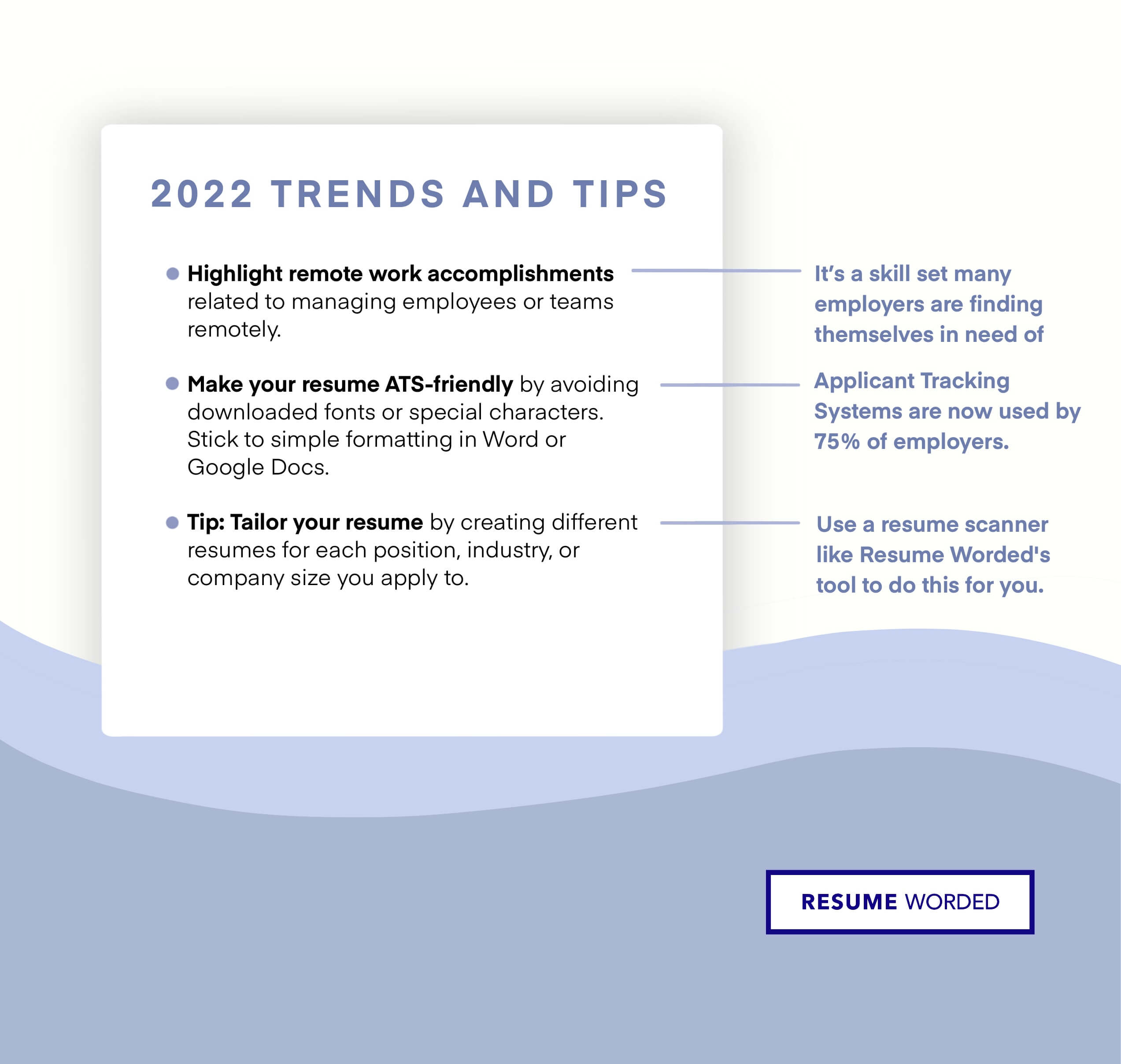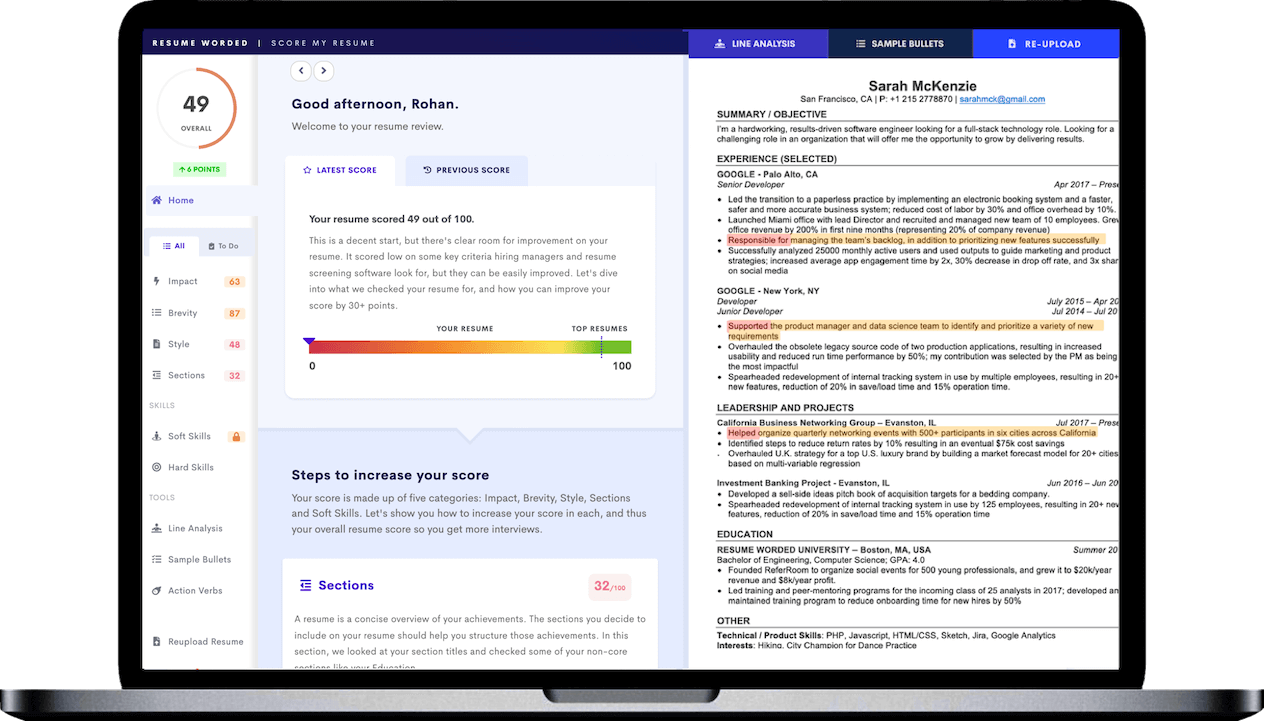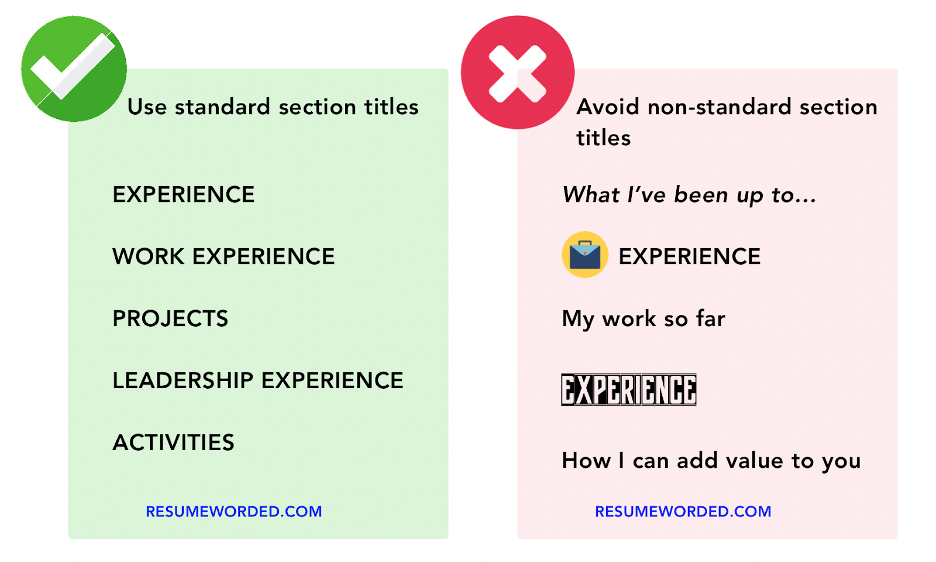The past couple of years have seen more changes in the job market than ever before. The result has been more opportunities than ever for many job seekers — and, of course, the need to update your resume to take advantage of them. Luckily, that doesn’t mean you need to start from scratch! In this guide, we’ve compiled a list of 32 actionable resume tips for writing a resume in 2025, including information on up-to-date trends and what hiring managers are really looking for.
Browse this guide for tips on formatting and keywords, navigating a career change, targeting your resume, addressing employment gaps, optimizing your online resume and more.
The trend in 2025: Applicant Tracking Systems
Applicant Tracking systems (ATS) are here to stay in 2025, with 75% of employers now using ATS to partially automate the hiring process. This means it’s more important than ever to ensure your resume is reader-friendly, whether that reader is a human or a machine.
Resume tip: Make your resume ATS-friendly
To make sure your resume can be easily read by ATS software, don’t use special downloaded fonts or special characters, but stick with traditional fonts like Arial, Calibri, or Times New Roman instead. Use simple formatting in Word or Google Docs. When creating your resume, stick to a one column format, or download a free ATS-ready resume template. For more detailed tips, read our guide on how to beat ATS.
Resume tip: Use relevant keywords
ATS are programmed to scan your resume for important keywords, so make sure they’re in there! Read the job description carefully to pick out key requirements, browse for common skills and keywords by industry and job title, or use our job description keyword finder to generate competitive keywords based on the job posting.
The trend in 2025: Targeted resumes
Gone are the days when you can send the same resume with every application. Now, the expectation is that you tailor your resume to the specific job so a recruiter can easily see why you are the right candidate for the position.
Resume tip: Tailor your resume content
While your experience remains the same no matter what job you’re applying for, your resume shouldn’t. Writing a targeted resume involves including keywords and skills, listing your accomplishments in order of relevance, and removing previous experience if it’s no longer relevant.
The easiest way to tailor your resume to a specific position is to use our Targeted Resume Tool. This tool analyzes the job description, identifies keywords and skills missing from your resume and provides actionable advice on how your resume can be improved.
Resume tip: Include the specific job title
Ensure the title of the job you are applying for appears at least once on your resume. For example, if you are applying for a Data Analyst position, refer to yourself as a Data Analyst in your resume summary, resume header, or work experience section. Including the exact job title won’t just help you get past ATS, it’ll also signal to a hiring manager that you’re the perfect fit for the role.
Resume tip: Start with a resume summary
Begin your resume with a resume summary. This brief section should include your most significant achievements, essential skills, and career aspirations, as well as your targeted job title, as explained above. While resume summaries aren’t always necessary, they’re great if you’re changing careers, can help you catch a recruiter's attention, and are common for high-level executive resumes.
The trend in 2025: Online resumes
The trend of online resumes continues to grow in 2025, especially in tech-focused and creative industries, with sites like LinkedIn fast becoming many recruiters’ first choice for posting positions and finding suitable candidates.
Resume tip: Embrace online resumes and portfolios
Online resumes and portfolios aren't just for creative professionals anymore. Platforms like LinkedIn and Monster allow applicants to showcase their resumes, include links to previous projects, advertise testimonials from employers, and connect directly with recruiters. Many of these platforms are free and easy to use, and you should be utilizing them for a job search in 2025.
Resume tip: Optimize your LinkedIn profile
LinkedIn remains a crucial platform for online resumes. In fact, many employers today will expect to find a comprehensive LinkedIn profile attached to your application.
Make sure to keep your profile up-to-date and optimized for the platform. Use LinkedIn's features to your advantage – include a professional headshot, craft a compelling headline, use the LinkedIn summary section to express your career aspirations, and fill in all the details of your work experiences. Use our LinkedIn Optimization Tool for further tips and feedback on optimizing your LinkedIn profile.
Resume tip: Include your LinkedIn profile on your regular resume
Include the address of your LinkedIn profile on your regular resume under contact information or in your resume header. You can make this address a clickable link on a PDF or Word document, or as part of your email signature when corresponding with recruiters.
The trend in 2025: Bullet points and power phrases
The key to writing a powerful resume is keeping your statements concise, memorable and to the point. The less a recruiter has to read, the better.
Resume tip: Use bullet points
Whenever possible, use bullet points instead of long paragraphs to keep your resume short and easy to scan. Choose accomplishments from your work history that reflect the duties mentioned in the job description, and use a resume bullet point builder to help construct your bullet points. Aim for 3-6 bullet points for more recent jobs, or 1-2 for older positions.
Resume tip: Start with an action verb
The most reliable way to keep your resume focused on accomplishments is to start every bullet point with an action verb. This keeps the spotlight firmly on what you did and helps frame your achievements in a positive, proactive light.
Use our comprehensive action verb database to choose from 200+ action verbs broken down by category. Vary your word choice by using synonyms of the most common resume power verbs, and remember to use the past tense in your action verbs. For example, use Managed instead of Manage or Manages.
Resume tip: Include metrics
Listing what you accomplished at previous jobs is good, but highlighting the end result or benefit to the company is even better. Using numbers and metrics to quantify your accomplishments makes it easier for recruiters to see what skills you’re bringing to the table and visualize how you’re likely to perform in the new role, bringing you one step closer to getting hired.
Resume tip: Use resume power phrases
Combining a strong action verb with a quantifiable result and metric is known as a power phrase, as they add power to your statements and help make your resume memorable to a recruiter. Use this formula throughout your resume, summary, and work experience to create an impactful resume.
Resume tip: Highlights the right skills
When it comes to listing past experience on your resume, focus on highlighting accomplishments and transferable skills that are relevant to the position you’re applying for.
Find out if your resume includes the right accomplishments and transferable skills by uploading your resume to the tool below. It’ll let you know if you’ve chosen the right skills, used enough numbers or metrics to quantify your accomplishments and also if you’ve chosen strong action verbs.
The trend in 2025: Remote work
While some companies are calling their workers back to the office, there are still companies embracing the move towards working from home. Highlighting your experience with remote work can be a major asset to your resume in 2025.
Resume tip: Highlight remote work experience
Working from home offers its own challenges, so companies love to see candidates who already understand the skills required for remote work. When describing your experience in a remote position, list specific remote platforms you worked with, such as Slack, Google Workspace, Microsoft Teams, or Trello, and include these in your hard skills section.
The rise in remote opportunities also means there is a real market for people with remote management experience. If you’re applying for a company that offers remote work, whether your position is in-person or not, make sure to highlight accomplishments related to managing employees or teams remotely.
Here’s a few examples of resume bullet points that highlight remote work accomplishments:
- Managed a remote, 5-member cross-functional team and coordinated with six senior business partners toward the successful launch of an e-commerce platform, using Trello, Slack and Google Workspace
- Identified, assessed and onboarded 12 mid-level remote employees in <6 months
- Led over 12 software sales pilots remotely, generating $500K+ total revenue in license and consulting service fees in 2020-21
The trend in 2025: Avoid buzzwords and soft skills
It feels like just yesterday that candidates were encouraged to add buzzwords to their resumes, but in 2025, the verdict is in, and buzzwords are out!
Resume tip: Avoid meaningless buzzwords
Buzzwords are overused, subjective phrases that provide no quantifiable proof of your experience and can actually make a recruiter less likely to read your resume. Examples of buzzwords include hard worker, team player, motivated or goal-orientated. Replace these terms with action verbs and quantified metrics to exemplify your skills and experience in a way that a recruiter can understand.
Resume tip: Emphasize soft skills via your accomplishments
Soft skills are just below buzzwords when it comes to things not to list on your resume. Anyone can claim to be a great leader or have excellent communication skills; the trick is to prove it. The best way to do this is through your work experience bullet points; for example, by detailing the size of the teams you’ve led, or highlighting a conference you presented at or a paper you wrote. To read more, check out our guide on how to include soft skills on your resume.
The trend in 2025: Focus on accomplishments
If you’re still listing duties or responsibilities on your resume in 2025, it’s time to put an end to that. Potential employers want to know what you’re likely to achieve in the job they’re hiring for, and the best way to do that is to look at what you’ve accomplished in similar roles in the past.
Resume tip: List accomplishments over roles and responsibilities
When listing your previous work history, describe achievements, qualifications and accomplishments instead of a list of roles and responsibilities. A potential employer wants to know what you did, not what you were supposed to do.
Resume tip: Focus on hard skills
Focus on the hard skills you gained during your previous employment, and exemplify each skill with a quantifiable accomplishment. This helps show a recruiter the skills you gained in each previous job and how those skills are relevant to their industry and position.
Use the tool below to find out the hard skills and keywords recruiters in your industry look for in a resume.
The trend in 2025: Simple formatting
Recruiters only spend a few minutes scanning your resume, which means that making your resume easy to skim should be one of your top priorities in 2025.
Resume tip: Stick to one page
Try to keep your resume to one to two pages. Any longer, and a reciter will likely stop reading, making any subsequent pages all but useless. To help trim your resume to one page, remember to be concise with your descriptions, cut irrelevant experience, use short power phrases, and focus on recent accomplishments within the last 15 years.
Resume tip: Steer clear of complex formatting
Fancy resume templates may look enticing, but complicated formatting, graphics and images can distort when sent to an employer or saved in a different file format. To be safe, stick to simple layouts and avoid adding graphs, colours or images to your resume. Text-based resumes also look more professional and are easier for ATS software to scan.
Resume tip: Use reverse chronological order
The most common way to list your work experience is in reverse chronological order, with your current or most recent job at the top. This is how modern recruiters will expect your resume to be formatted.
However, if your most recent experience is not your most relevant experience for the job you are applying for, you can separate your work history into a ‘Relevant Experience’ and ‘Other Experience’, but every job should have your job title, company, and dates of employment clearly listed.
Resume tip: List your sections in order of importance
As we have mentioned, many recruiters only scan your resume and stop reading when they lose interest. This means your resume should be formatted in order of importance. Your work experience section should be at the top of your resume, and less important sections (like education, projects, and other information) at the bottom.
There are exceptions to this rule — if you’re a current student or recent graduate, you can list your education section first. If you’re changing careers, you can prioritize relevant experience or more recent qualifications.
Resume tip: Use white space
Ever heard the expression “less is more”? It applies to your resume, too. Instead of filling your resume with as many skills as you can, focus on the quality of the experience you choose to list over quantity, and leave white space (space not filled with words) to give your words room to breathe.
Use standard margins and font sizes, and leave space between the different sections of your resume. This will make your resume easier to skim and help the most important information stand out.
Resume tip: Polish your resume
With so many options for spell-checking your resume, there’s no excuse for typos. Always thoroughly proofread your resume, as even a single mistake could cause a recruiter to move on to another candidate. If you don’t want to leave anything to chance, use a free resume checker to proofread your resume and offer suggestions on areas to improve before you hit Submit.
The trend in 2025: Navigating career changes
Career changes have become more common than ever before due to the global pandemic's effects on various industries. Here's how you can make your resume reflect a successful career pivot and optimize your past experience for applications in new industries.
Resume tip: Highlight transferable skills
The first step when changing careers is to identify which skills from your previous roles are transferable to your new industry. These can include soft skills like leadership and communication or hard skills that can apply across industries, like project management or data analysis.
When you list these skills on your resume, it’s not enough to simply state that you possess them. Instead, include specific examples of when and how you used these skills professionally. Remember, hard skills will be listed in your skills section, while soft skills should be exemplified in your work experience.
Resume tip: Consider gaining new qualifications
In some cases, you might need to go back to school or gain new qualifications to make a career switch. Online learning platforms like Google Career Certificates make this process easy and are a great addition to your resume. Don't be shy about listing relevant courses or certifications on your resume; it demonstrates a commitment to your new field, and you can even include courses you are enrolled in or yet to complete, to show that you are actively improving your skills.
Resume tip: Rebrand your job descriptions
Another strategy for navigating career changes is to revise your past job descriptions and titles. Of course, you should always be truthful on your resume, but you can tweak how you present your past roles to make them more relevant to your new field. Focus on the responsibilities and achievements from your past positions that align with your new career path. This can help prospective employers see how your experience is valuable, even if it’s in a different field.
The trend in 2025: Addressing gaps in your employment history
Having gaps in your employment history is quite common, particularly following the recent pandemic. However, it's important to address these gaps appropriately on your resume.
Resume tip: Be honest but concise
First and foremost, honesty is crucial. Don’t try to hide employment gaps by altering the dates of previous employment. Dishonesty is much more harmful to your application than an employment gap.
That being said, it's not necessary to provide a detailed explanation about the gap in your resume. Your resume should be a concise summary of your professional history, so if you took time off for personal reasons, you can simply note the time period and leave it at that.
Resume tip: Highlight productive activities during the gap
If you took part in education or activities during your employment gap that enhanced your skills or knowledge, mention this on your resume. This can include volunteer work, freelance projects, courses or certifications, or even self-taught learning. For example, if you were unemployed for six months but during that time you completed a project management certification, you can include this in the education or professional development section of your resume.
Resume tip: Employment gaps aren’t that big a deal
You don’t have to go into too much detail about your employment gap on your resume. You can expand on your gap in your cover letter or during an interview, where you can explain the reasons for the gap in a positive light and emphasize how you used the time productively to prepare for your return to the workforce.
Remember, an employment gap does not automatically disqualify you from consideration for a job. Many recruiters understand that life happens, and as long as you can demonstrate that you're ready to jump back into work, they will consider your application seriously.
The trend in 2025: Networking
Okay, so networking isn’t exactly a new trend, but in 2025, it’s more important than ever — here are networking tips for 2025. Even with hundreds of job boards available at your fingertips, sometimes it’s the personal touch that can really push your application over the edge.
Resume tip: Follow up with the hiring manager
If you haven’t heard back from a job application, it’s time to follow up. Even a quick email can help establish that all-important personal connection and prevent your resume from slipping through the cracks. If you’re unsure exactly how to go about it, check out our guide to following up on a job application, including email templates you can copy and paste.
Related: Banish Boring Subject Lines With These Key Email Tips
The trend in 2025: Modern expectations
Not all resume tips are created equal. Some resume trends haven't been current in years, and some have never aligned with what hiring managers actually want to see.
Resume tip: What trends recruiters don’t want to see
Here's a brief (but non-exhaustive) list of things recruiters don't want to see on your resume:
- A functional resume format: There are better ways to make up for a lack of work history than leaving off dates and job titles. Instead, focus on accomplishments and highlight transferable skills.
- Resume objectives: A resume objective typically focuses on what you're looking for rather than on what you can bring to the role. Switch this section for a targeted resume summary.
- A full street address: Under contact information, list your City, State, and/or Country, instead of a complete street address. Email is a far more common mode of communication, so a street address is no longer needed on a modern resume.










